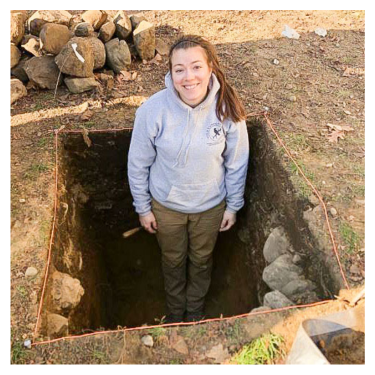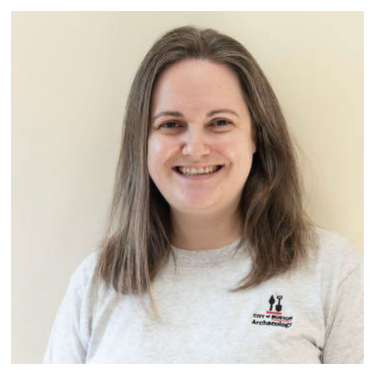Meet the City Archaeology Team
The City of Boston Archaeology Program is made up of four people who work to carry out the program's mission: to celebrate Boston’s diverse history through preservation, excavation, and community engagement.
You may be familiar with Boston’s City Archaeologist, Joe Bagley, but did you know that there’s a whole team behind the Archaeology Program’s efforts? The City also has an Archaeology Laboratory Manager, and a grant-funded Digital Archaeologist and Project Archaeologist. Meet the team!
Nadia Kline, Digital Archaeologist
How long have you worked with the program?
I started volunteering at digs with the program in 2013 and was hired as Digital Archaeologist in 2019.
What are your main duties?
I work to digitize our collections using a few methods. I catalog and photograph collections, then I create public databases with photos and metadata so everyone can see exactly what we have stored at the lab. I develop 3D models of artifacts using laser scanning and photogrammetry so the public can view artifacts virtually and even print their own 3D models of them.
I also create social media content and manage our channels, keep the program’s website up to date, help conduct excavations during our field season, and write proposals and site reports.
Where have you done archaeology?
Alaska, New York, New Jersey, and every state in New England. I was a field and lab technician doing contract archaeology for several years before joining the City Archaeology Program. I grew up down on the South Shore so it's been really cool sort of relearning the epic Boston history we learned as kids through an archaeological lens which focuses more on everyday people.
Any special interests?
I love studying personal adornment (items people wore like buttons, buckles, jewelry, etc.) and historic dress. I even wrote my master’s thesis on it. It’s so interesting to think about how people communicated through dress and how it influenced the way they moved around in the world and interacted with other people and their environment. There’s something really special about holding an item that somebody wore on their own body hundreds of years ago.
I’m also passionate about historic preservation and public archaeology. They both play a huge role in how people connect to different spaces and understand their own place in the community. Joining the City Archaeology Program has allowed me to explore that in a way I wasn’t able to before. Truly a dream job!
Lauryn Sharp, Project Archaeologist
How long have you worked with the program?
I started with the program as a field technician working on the First Church in Roxbury in May 2019 and was hired as Project Archaeologist in August 2019.
What are your main duties?
I primarily work on sorting, cataloging, and photographing grant-funded archaeological collections, while also assisting and supervising volunteers (stay tuned for volunteer opportunities when our new lab opens!). I also design and create social media posts during our projects so the public can see some of our highlights or important materials we come across during our day-to-day work.
Prior to our field seasons or projects, I help to generate proposals and after projects are completed, I assist with writing reports. During our field seasons, I primarily excavate but also help to manage our digs.
Where have you done archaeology?
I did private CRM (Cultural Resource Management) compliance work all around Virginia before moving to Boston. Prior to that, I worked in the Shenandoah Valley and North Carolina. After moving to Boston for grad school, I worked in Concord, Cape Cod, Plymouth, and Connecticut. With the City, I have done work in the Roxbury, Chinatown, Dorchester, North End, South End, and Jamaica Plain neighborhoods.
Any special interests?
One of my favorite tasks is archival work. There is nothing better than starting a research project with a few basic facts about a person or property and being able to create a whole narrative about their lives, livelihoods, and families. The paper trail sometimes seems endless and it is so interesting to get your hands on contemporary materials that they sometimes had a hand in writing. Despite the millions of frustrating rabbit holes you often can find yourself in, it is so exciting to find the one answer to a question which your research is fixed on.
Besides this method of investigation, my masters degree research focuses on 18th century urban craftsmanship and this has fast become an important interest of mine. Sadly, this is an often overlooked aspect of 18th century research, so to be able to contribute to this literature and research is especially meaningful for me.
Sarah Keklak, Lab Manager
What’s your title?
Archaeology Laboratory Manager
How long have you worked with the program?
I was first introduced to the program back in 2012 when I was in graduate school. For several years I worked with the City of Boston Archaeology as a volunteer and then as a contractor, but have been in my current role as the Lab Manager since 2019.
What are your main duties?
As the lab manager I oversee the care and management of the collections including newly acquired collections, current collections, and legacy collections. The status of each collection helps determine the needs of the collection. Collections can have widely varying needs ranging from general organizing to complete processing including washing, sorting, cataloging, and digitization of the collection.
This Fall dig season was quite exciting! Even though excavating can be the most visible part of archaeology, digging is just part of all the work that goes into telling the many stories of a site. After a collection is excavated all the bags of artifacts must be processed, which includes washing, sorting, and cataloging. Although most of my work is at our Lab, my work begins in the field. I make sure that the artifacts and where they came out of the ground is all organized, so that processing is much easier. Currently, I have begun washing the artifacts from our recent digs!
Where have you done archaeology?
I have always had a love for the past. I wanted to be a paleontologist when I was younger, but this evolved to wanting to study archaeology! Before going to college, I joined several excavations in New Jersey, Virginia, and Maine. Since joining the City of Boston Archaeology Program I have participated in many digs in Boston.
Any special interests?
I have always loved puzzles! Surprise, surprise. Much of what I do involves physically handling the artifacts, especially ceramics. I cannot help myself finding sherds that can be refitted. If any of the sherds have identifying features such as maker marks or printed decorations, I automatically start going down the rabbit hole in trying to further figure out as much as possible about the ceramic.




